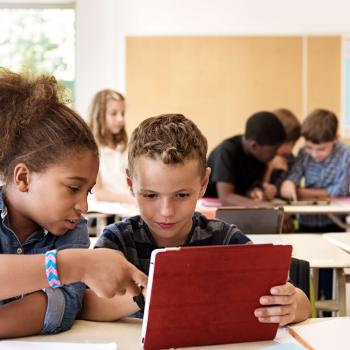Using the Think-Pair-Share Technique

About this Strategy Guide
In this strategy guide, you will learn how to organize students and classroom topics to encourage a high degree of classroom participation and assist students in developing a conceptual understanding of a topic through the use of the Think-Pair-Share technique.
Research Basis
The Think-Pair-Share strategy is designed to differentiate instruction by providing students time and structure for thinking on a given topic, enabling them to formulate individual ideas and share these ideas with a peer. This learning strategy promotes classroom participation by encouraging a high degree of pupil response, rather than using a basic recitation method in which a teacher poses a question and one student offers a response. Additionally, this strategy provides an opportunity for all students to share their thinking with at least one other student which, in turn, increases their sense of involvement in classroom learning. Think-Pair-Share can also be used as in information assessment tool; as students discuss their ideas, the teacher can circulate and listen to the conversations taking place and respond accordingly.
In this strategy, a problem is posed, students have time to think about it individually, and then they work in pairs to solve the problem and share their ideas with the class. Think-Pair-Share is easy to use within a planned lesson, but is also an easy strategy to use for spur-of-the-moment discussions. This strategy can be used for a wide variety of daily classroom activities such as concept reviews, discussion questions, partner reading, brainstorming, quiz reviews, topic development, etc. Think-Pair-Share helps students develop conceptual understanding of a topic, develop the ability to filter information and draw conclusions, and develop the ability to consider other points of view.
Strategy in Practice
- Before introducing the Think-Pair-Share strategy to the students, decide on your target for this lesson. You may choose to use a new text that the class will be reading, or you might want to develop a set of questions or prompts that target key content concepts that you have been studying.
- Describe the strategy and its purpose with your students, and provide guidelines for discussions that will take place. Explain to students that they will (1) think individually about a topic or answer to a question;(2) pair with a partner and discuss the topic or question; and (3) share ideas with the rest of the class.
- Using a student or student(s) from your classroom, model the procedure to ensure that students understand how to use the strategy. Allow time for students to ask questions that clarify their use of the technique.
- Once students have a firm understanding of the expectations surrounding the strategy, monitor and support students as they work through the steps below. Teachers may also ask students to write or diagram their responses while doing the Think-Pair-Share activity.
- Think: Teachers begin by asking a specific higher-level question about the text or topic students will be discussing. Students "think" about what they know or have learned about the topic for a given amount of time (usually 1-3 minutes).
- Pair: Each student should be paired with another student. Teachers may choose whether to assign pairs or let students pick their own partner. Remember to be sensitive to learners' needs (reading skills, attention skills, language skills) when creating pairs. Students share their thinking with their partner, discuss ideas, and ask questions of their partner about their thoughts on the topic (2-5 minutes).
- Share: Once partners have had ample time to share their thoughts and have a discussion, teachers expand the "share" into a whole-class discussion. Allow each group to choose who will present their thoughts, ideas, and questions they had to the rest of the class. After the class “share,” you may choose to have pairs reconvene to talk about how their thinking perhaps changed as a result of the “share” element.